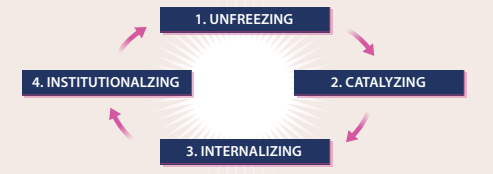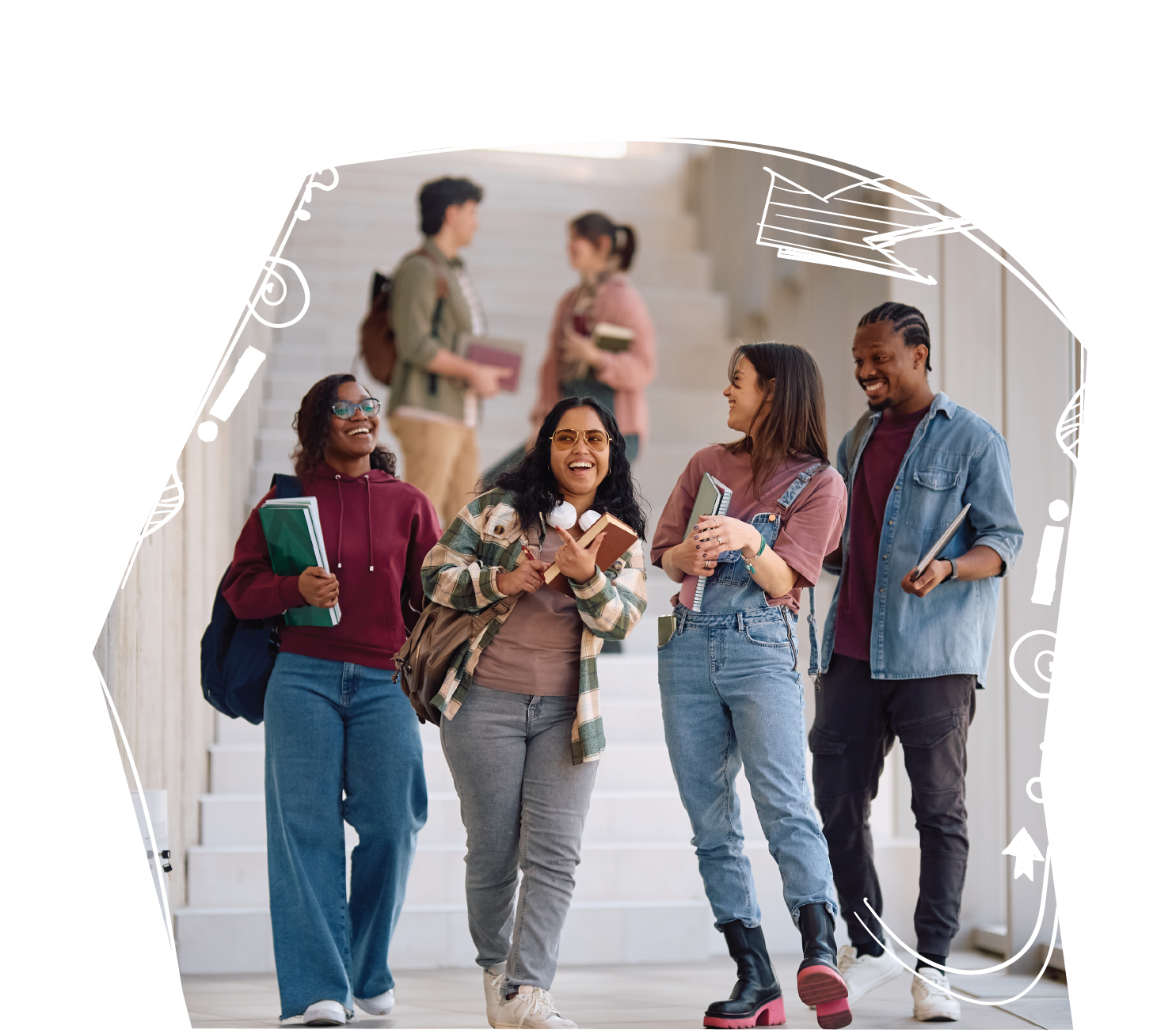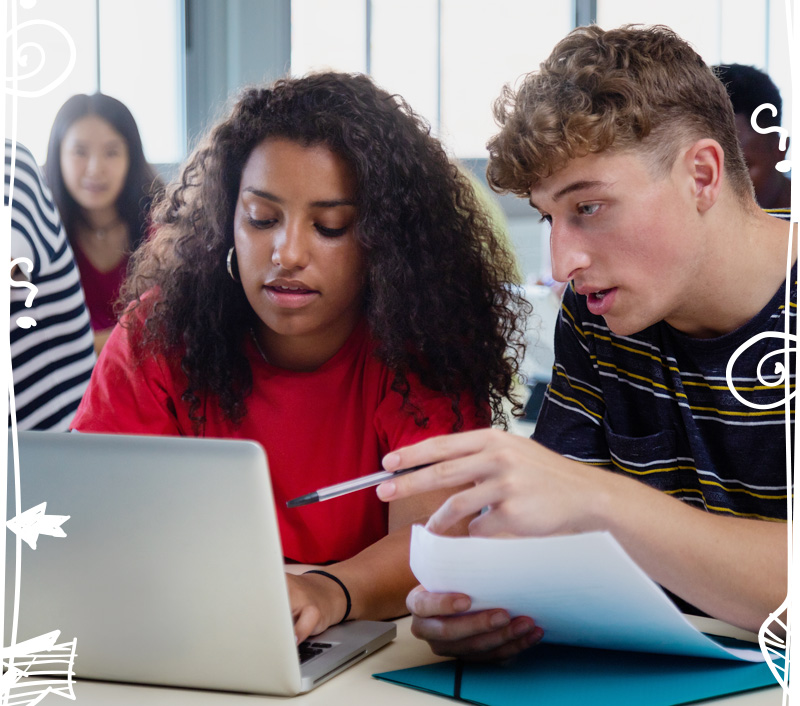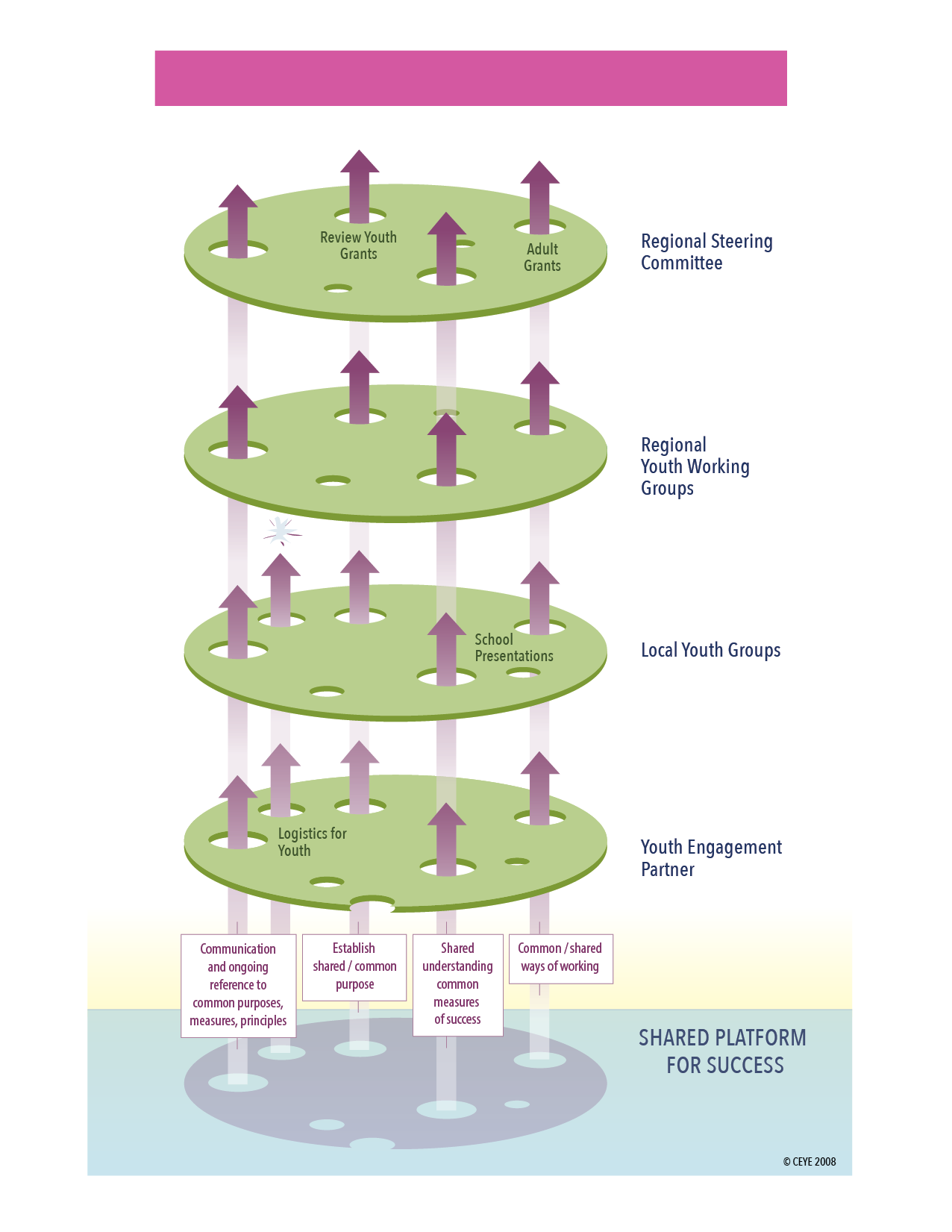By this point, you likely have a good understanding of what youth engagement is all about and why it’s so important. This “how-to” section describes the hands-on process, offering tools and evidence-based practices to effectively engage young people both in-person and online. The How-to Guide is organized by the CEYE Conceptual Model of Youth Engagement and provides tips and techniques to initiate, sustain, and deliver meaningful youth engagement programs and activities.
Remember, integrating youth engagement at the system or organizational level requires conditions of readiness and change.
FOUR STAGES OF CHANGE to Promote Youth Engagement:

Kirby’s Institutionalizing Participation Framework19 describes four stages of change in order to promote youth engagement:
Unfreezing involves recognizing the need to change and unblocking existing attitudes and styles of working. Both existing beliefs and practices, and external pressures (e.g. government, funders, etc.) need to be unfrozen.
Catalyzing knowledge into action can be facilitated by establishing “champions” within organizations and systems. Catalyzing needs to be supported by senior management and involve youth early in the process, as the vision for youth engagement is set against current culture and politics in the organization/system.
Internalizing change involves building staff capacity with time and resources for recruitment, training, practice, and evaluation, so that engagement becomes sustainable within organizations and systems.
Institutionalizing youth engagement into policy and standards is necessary for it to become mainstream practice.
The indicator frameworks that are included in each section of the How-to Guide use these four stages of change as benchmarks.
So you know that youth engagement is important and you want to enhance youth voice and opportunity in your school, ministry or organization – now what? This section outlines key steps to initiating youth engagement.
Steps for Policy & Decision Makers:
- Initiate the Culture Shift
- Assess Organizational Readiness
- Find the Internal Catalyst

Steps for Practitioners:
- Engage Young People Early
- Establish Shared Objectives
- Establish Partnerships
- Maintain Frequent Contact
- Identify Background Research Questions
- Use Expertise Collaboratively
- Consider Diversity
- Recruit Young People
- Provide Pre-engagement Activities
- Prepare Youth-friendly Materials
- Develop a Logistics Plan
- Familiarize yourself with online tools for virtual engagement
”I try to help the decision makers understand that in order for young people to be engaged, they need to be brought into the process. Sometimes it’s just a teaching opportunity. I ask them: What’s our real outcome, and how are we going to get there? Usually involving young people is key.
Joyce SunadaEver Active Schools, School Coordinator, AB (2014)
”It was fun, I met a lot of great people and feel like I can make a difference.
Youth Participant
Kickstart Youth Engagement Guide
To access “Youth Engagement Defined” video click above.
Initiating Steps for Policy & Decision Makers
1. Initiate the Culture Shift
At the system level, the first step towards meaningful youth engagement is often about shifting cultures. This means unfreezing the existing culture and identifying the strengths and areas where youth engagement might already be happening or has the potential to be initiated. Champions catalyze cultural shifts by helping others understand the value and need for youth engagement. Champions highlight examples of success and actively look for and create opportunities to engage young people in projects, policy development and/or governance.
2. Assess Organizational Readiness
At the system level, three key conditions need to be in place for children and youth to participate in decision-making:
- Cultural attitudes that encourage youth participation;
- Political, legal, and administrative structures which ensure rights to participation; and
- Economic and social conditions that enable people to exercise their rights.
As a school, organization, or government body interested in enhancing youth voice, understanding where you are at will help identify key areas for change and action. The Spectrum of Youth Engagement is one helpful way to identify where your organization is starting from and where you want to be.
3. Find the Internal Catalyst
Organizations and government bodies (systems) get involved with youth engagement for specific reasons, just like young people do. For example, researchers might be motivated to engage youth in creating their teen health survey, in order to ensure the language is relevant to their target audience. This is how the culture of youth engagement often starts – with a specific project. In most instances, the project acts as a catalyst, leading to a greater understanding and appreciation of youth voice and participation. Once governments and organizations have experienced the benefits of youth engagement firsthand, they generally embrace other ways to involve young people in decision-making, policy development, and programming.
As a champion of youth engagement, look for the internal catalyst and use the opportunity to not only engage young people, but also to engage adults in your sector. Give adults the chance to interact with young people and experience youth engagement firsthand. This experience will go a long way to shifting perspectives.
Initiating Steps for Practitioners
1. Engage Young People Early
Young people should be involved early in the process of planning an activity or initiative – this includes generating project objectives. Young people will bring valuable ideas and perspectives to the table and can help ensure the initiative will resonate with other youth.
Young people often get excluded from these early stages due to adult assumptions about their interests or skills. Counter to these assumptions, many young people enjoy strategic planning and have lots to contribute. In addition to their own learning, youth also teach adult members a great deal about practicing and modeling effective youth engagement throughout the entire project.
2. Establish Shared Objectives
When you have multiple partners and stakeholders it is important to establish shared objectives, values, and principles for an initiative. Take the time to learn what brought people to the table, what they are hoping to achieve, and how they want to achieve it. Initiators occur at individual, social, and system levels. Be deliberate about considering all three levels – establish objectives and principles that will meet each stakeholder’s interests (youth, policy makers, community organizations, academics/experts).
Evaluate Your Readiness
Interested in assessing your organizational readiness to engage youth? Check out this evaluation resource: Organizational Readiness Module or online at Sharing the Stories.
This should include “checking assumptions” to ensure mutual understanding. For instance, if a committee believes the project should be “youth-led” have a discussion about what that looks like. What are the roles of adults in a youth-led initiative? Setting common objectives, principles, and values will provide an ongoing frame of reference that helps decision-making and execution throughout the project process.
3. Establish Partnerships
Partnering with an existing advisory group or youth serving organization is an efficient and effective way to facilitate young people’s engagement. Partnerships bring diversity and strength to a project and can be a great way to learn new practices. Organizations that work directly with young people on a daily basis will be in a position to recruit young people, support their involvement, and help develop activities that will resonate with their youth. These organizations will also be able to support youth-adult partnerships early in the planning process.
4. Maintain Frequent Contact
Meeting on a regular and frequent basis helps an organizing committee define the tasks that will achieve their objectives, collaborate on task execution, and review decisions as required. It also helps foster relationships, which are key to effective youth engagement. If partners have not worked together before, there is, ideally, a face-to-face meeting early on in the planning stage. After that, regular contact and decision-making can readily occur through conference calls and online communication (such as email or Microsoft Teams). When engaging young people in a planning committee, be mindful of supporting transportation needs, meeting during times that are convenient for young people and using language and working styles that are accessible to youth.
5. Identify Background Research Questions
Building off of the project objectives, the planning committee should outline the key questions for which youth input is sought. So for instance, if a planning committee is interested in developing school policies that encourage physical activity, they might outline a number of questions they want answered by students: What motivates you to be active? How can teachers and staff encourage physical activity? What school-wide physical activities or events would interest you? Identifying these research questions early will help in the development of youth engagement materials and activities.
6. Make Use of Expertise
Everyone brings different, yet valuable skills and expertise to the table. Most planning committees should include individuals with policy/program expertise, those with research and content background, those with youth engagement experience, and those with first-hand experiences of the “issue” in question. (Often, this is young people!) Ensure that the expertise each person brings to the process informs the work of others. For example, researchers can help ensure that a youth engagement process will also provide accurate research deliverables. Likewise, young people can ensure that the research findings are relevant and that materials researchers prepare are presented in the most effective language and style for participants.

Youth Engagement in Policy and Practice
Kathy Berggren-Clive, with the Ministry of Children and Family Development in British Columbia, as part of her work, promotes and supports the engagement of young people in policy, service, and program development. The BC Child and Youth in Care Week, which celebrates young people in and from government care, was a direct recommendation from youth consultations. Youth were also involved in the development of the new Care Plan for children and youth in care, the Youth Engagement Toolkit, and the MCFD Complaints Youth Brochure. Youth engagement is central to the work of the ministry. Engaging youth contributes to the effectiveness of programs, services, and policies. It helps keep organizations enthusiastic, energized, and informed. It also supports young people to develop to their full potential and nurtures the next generation of advocates for youth. “At the ministry, it’s about continuous quality improvement. We need to understand the perspective of the client – to help inform and improve our services.”
7. Consider Diversity
Youth, researchers, and policy makers all benefit when diversity is prioritized. The criteria for youth participation should be determined by the initiative: if it relates to living with a disability, it makes sense to recruit youth with disabilities. In many situations, policy makers and program developers are interested in ensuring that ethnic, racial, linguistic, geographical interests, and lived experiences are all represented.
Striving for socio-economic diversity and diversity in terms of academic performance are also important. There is sometimes a belief that youth who are not doing well in school will not be interested in policy or program development. However, social justice is often a real motivator for these youth. They have much to teach advantaged youth, and adult allies, if given a safe space to do it. Work to create a safe space, both online and offline, where all young people have room to participate in multiple ways. Young people can participate in policy or program development online by joining virtual advisory boards or focus groups, engaging in online surveys and feedback sessions, and collaborating on digital platforms like forums or social media. They can also contribute by participating in webinars, online workshops, and virtual town halls, where their input can directly influence decisions and strategies.
Young people who might appear disengaged can bring great insight into an issue, often because of their lived experience. Research demonstrates that the more diverse the participant experience, the more positive the outcomes youth report during an event or program.20
8. Recruit Young People
There are many initiating factors that might lead a young person to get involved with a project, program, or initiative. They may be attracted by a monetary honorarium, the chance to travel, or a desire to make change in their community. Acknowledging these motivations is a useful way to recruit and plan for engagement experiences that meet a variety of needs and interests.
Create materials to explain the initiative and what is expected of participants. Applications and recruitment materials can encourage youth to start thinking about key concepts related to a project. However, take care that your application process and materials don’t scare off disengaged youth. Leave room for “showing up” with a mentor or friend. Questions about applicants’ thoughts, interests, and connection to a topic can also provide additional criteria to ensure diversity. Strive for a collective balance of diverse experiences rather than an individual-focused competition.
Direct face-to-face, telephone, email, and social media engagement with youth, their organizations, and adult allies, helps build interest and comfort. “Shoulder tapping” and word-of-mouth recruitment are very important tools to support young people to become involved, especially those less-likely to participate.
9. Provide Pre-Engagement Activities
For Youth: Preparatory activities can help get young people excited and informed for an upcoming project. This could be an online survey as part of the application process, a video conference call with selected participants, or tasking young people to survey their friends and family about an issue. Activities like these help young people understand the concept of “constituency” and representative voice, encouraging them to think about the similarities and differences between their own experience and the experiences of others. Unfortunately, many youth are put in a position where they are asked to speak on behalf of all young people, without adult support to learn about constituency building. If young people will be engaging in a position where they are expected to represent “youth voice” (for example, sitting on an advisory committee, or board of directors…) it’s important to teach them about consulting others.
For Adults: Adults are often unsure of their role at a youth engagement event or initiative and preparation and guidance for them is important. In some cases, having adults fill out pre-engagement quizzes, surveys, and permission forms, similar to youth, can be a useful way to get adults to reflect on their experiences and how they may relate/differ from those of young people. Youth-led “adult ally trainings” which focus on how to build supportive and positive partnerships between young people and adults can also help prepare adults for their role during an event or project. Ideally, adults are neither too directive nor too withdrawn. Non-participation by adults who are trying to give space to youth voice can be perceived as disinterested, uncaring, and unsupportive. Adults should participate with youth, but be mindful of prioritizing youth voice and experience.
See the Adult Allies Training Manual and Adult Allies in Action booklet

10. Prepare Youth-Friendly Materials
Youth (and adults!) recommend bright colours, highlighted and bold text, and paragraphs presented in bullet form as effective ways to communicate information. The use of video clips, photos, and visuals is also recommended. Ultimately, it is important to create connections and relevance between the topics being discussed and young people’s lives.
Youth recommend that content prepared by policy makers and researchers for youth should contain visual representations that are simple and clear. For example, graphs should have simple headings that translate research concepts like “domain” into the real world equivalents, like “home” or “school.” Youth involved in the planning committee can be a great asset for developing materials that will be accessible and interesting to youth participants.
Initiating Action
Joyce Sunada, AB, School Coordinator, organized Shaping the Future Symposiums: Shaping the Future is an annual conference that brings together educators, health and wellness professionals and researchers to discuss aspects of Comprehensive School Health through a variety of interactive learning formats. Through engaging workshops and keynotes, the event explores insights from student voices on building a future-ready school community. Activities and conversations delve into creating healthy, engaging, and inclusive environments in schools and communities.
Shaping the Future 2025 will take place from January 30 – February 1, 2025.
11. Develop a logistics plan
Attention to logistical details can go a long way to supporting a successful initiative. Have a plan in place for collecting guardian consent, medical information, dietary restrictions, and photo/video release forms. Here are some sample forms to help. Likewise, be prepared to support transportation and accommodation needs, arrange meeting spaces, online links for virtual engagement (e.g., Zoom meeting links), a schedule/agenda, and support outings and activities.
It can be helpful to assign a logistics “lead” from the planning committee to ensure information is collected, programming arrangements are made, and logistics do not take over the planning related to process and content.
12. Familiarize yourself with online tools for virtual engagement
The COVID-19 pandemic prompted a global shift from traditional face-to-face teaching to online and hybrid learning methods. The change required significant adjustments in teaching practices and course design2. Incorporating interactive learning techniques and collaborative pedagogical approaches are fundamental in preparing students with the necessary professional skills to effectively apply their theoretical knowledge to practical, real-world situations15.
One way to encourage social interaction and improve presence in online courses is to incorporate design elements that facilitate active communication between students and teachers21. For instance, Zoom offers interactive and engaging features like emojis, chat functions, screen sharing, annotations, polling, breakout rooms, and live transcriptions. Collaborative applications like Slack and Discord also offer youth an engaging and interactive space to work collaboratively while chatting. By implementing these strategies, instructors can create an interesting and collaborative learning environment that promotes meaningful interactions and fosters a strong sense of community among students. Teachers who went out of their way to facilitate class interaction, learn how to use educational technologies, and collect feedback from students elicited positive perceptions.

Tips for Adult Allies:
Be “listeners”: Record significant points and comments made by youth and post them so that young people see their voice is heard.
Ask questions: Be inquisitive, rather than making statements, to avoid the assumption of authority conferred to adults. If something a youth says is inaccurate or inappropriate, use questions to prompt critical thinking. Give room for youth to make the point that you as an adult might want to make.
Be “you”: In day-to-day interactions, authenticity and honesty are the qualities youth most respect in adults, not “coolness,” humour, or celebrity status. Share appropriately who you are and what you do.
Seek input: Young people want to be part of the decision-making process. Before planning an activity, event or project, ask young people what they want.
Check your assumptions: Challenge negative assumptions you and/or other adults may have about young people. Not all youth are the same, be open to new and positive relationships.
Explain decisions and restrictions: If a youth suggested activity or idea is not possible (because of budget, timelines, appropriateness…) explain this to young people rather than just saying “maybe” or “no.”
Adapt and Learn: Stay open to feedback and be willing to adapt your approach based on the needs and preferences of the youth you’re working with.
Provide Positive Reinforcement: Acknowledge and celebrate achievements and contributions, no matter how small. Positive reinforcement can boost confidence and motivation.

Tips for Adult Allies with Virtual Engagement:
Be Present and Available: Make sure to be consistently present and responsive. Regular check-ins and maintaining open communication channels can help build trust and reliability.
Use Engaging Tools: Leverage interactive tools and platforms that make engagement fun and dynamic. Tools like virtual whiteboards, polls, and breakout rooms can make sessions more interactive.
Be Flexible with Communication: Recognize that not everyone communicates in the same way. Offer various methods for engagement, such as video calls, chat rooms, and email, to accommodate different preferences.
Provide Guidance and Structure: While allowing for creativity and expression, it’s also important to offer clear structure and guidance. Outline expectations and goals for virtual engagements to keep things organized and purposeful.
Foster Collaboration: Promote collaborative activities that allow young people to work together on projects or discussions. This can help build a sense of community and teamwork.
Address Digital Literacy: Ensure that youth are comfortable with the digital tools and platforms being used. Provide training or resources if needed to help them navigate virtual environments effectively.
Be Mindful of Screen Time: Balance virtual engagement with activities that don’t involve screens. Encourage offline activities and breaks to prevent burnout and promote overall well-being.
An Indicator Framework
Youth engagement is both a science and an art. There are promising practices that correlate to positive outcomes, yet there is no one “right” way to engage young people. The Indicator Framework developed for this toolkit offers a broad overview of the practices that correspond to effective qualities of youth engagement. For each section of the How-to Guide, the Framework outlines how these indicators might look at various benchmarks. The Assessment Tool offers practitioners a detailed list of indicators that will support them to assess their organizational practices and plan for the future. The indicators included in this toolkit are not meant to be a prescriptive and exhaustive list. Rather they offer a summary of promising practices. Some of these indicators may not be relevant to your context. Do not be afraid to start small or prioritize the areas where you would like to begin.

Assess Your Practice (Initiating)
Evaluation Tools
For further evaluation tools, please visit the Students Commission’s Sharing the Stories platform. This online evaluation platform includes academically validated tools to evaluate youth engagement. Check out these tools related to initiating youth engagement:
”We need to dispel the myth that youth engagement takes more time – the benefits that you get on the other end are far greater. Putting in a little more effort on YE up front saves time and creates greater benefits in the future.
Lynn Ann Duffley, NB
”We need more youth engagement champions who understand what it means to meaningfully involve youth in our work.
Morris GreenDepartment of Health & Wellness, NS (2014)
”When young people are heard and engaged in policy development, they influence whether that policy will be accepted or resisted by the youth community… They can also identify the counter arguments that we need to be prepared for. Their insight on policy or program development and implementation is extremely valuable.
Lynn Ann Duffley, NB
”We’ve had success this past year. Our pitch was simple: We really don’t know what’s going on inside the heads of youth when it comes to road safety. All we have is some quantitative data telling us youth are particularly vulnerable to injury on the roads. They understood the dilemma immediately and supported us to start some sensing work with youth. They were very happy with the initial work and are now supporting our next step to bring youth to the table.
Morris GreenDepartment of Health & Wellness, NS (2014), and GuysWork founder.
”Justice, Health and Education sectors need to work together on supporting young people.
Jill Lightwood, PEI
Connecting Layers of Engagement
”We only make place for one student, or two students at the table…then we expect them to be able to speak on behalf of all youth.
Lynn Ann Duffley, NB
”Using social media (TikTok, Instagram, Threads, Facebook, X) to engage youth is imperative. In saying that, face-to-face engagement does work best, but you still need to get them in the room…and keep them engaged through mechanisms that they tune into regularly.
Mellissa WoodDepartment of Municipal and Community Affairs, NT (2014)
”Loved the conference and so did the entire team. Everyone left feeling rejuvenated and calm.
DelegateShaping the Future
Definition
Constituency: gathering ideas and perspectives from peers, or people you represent
”This is the best conference I’ve ever attended. I loved how you could choose how much or little movement you wanted to incorporate in your day.
DelegateShaping the Future
”Shaping the Future is an engaging, memorable, and restorative option for professional development. The commitment to health and wellness… make[s] this conference unique.
DelegateShaping the Future
”It’s not one size fits all. A 19 and 12 year old are not developmentally the same.
Annie SmithExecutive Director, McCreary Centre Society (2014)
”I will think more of how to portray information to youth, to consider getting their opinions throughout work/research.
ResearcherHBSC Study
”Wisdom doesn’t just come from age – it comes from being a current member of a community
Lynn Ann Duffley, NB
”Shaping the Future is an engaging, memorable, and restorative option for professional development. The commitment to health and wellness… make[s] this conference unique.
DelegateShaping the Future
Definition
Indicator: provides evidence that a certain condition exists; it helps assess your progress towards an intended outcome or goal.
”This is the best conference I’ve ever attended. I loved how you could choose how much or little movement you wanted to incorporate in your day.
DelegateShaping the Future

